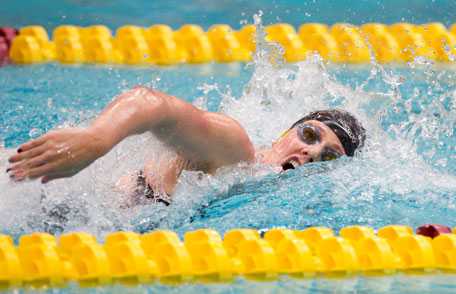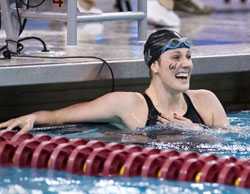Stories
These stories illustrate the importance of healthy swimming and can help promote health and safety messages.
Q&A with Missy Franklin: Olympic Gold Medalist and Healthy Swimming Champion
 Between swim practice, competitive meets, and college courses, we caught up with five-time Olympic medalist Missy Franklin for her tips on keeping swimming healthy, safe, and fun.
Between swim practice, competitive meets, and college courses, we caught up with five-time Olympic medalist Missy Franklin for her tips on keeping swimming healthy, safe, and fun.
CDC: At only 19 years old, you have five Olympic medals (four gold!), one world record, and two American records—and we’re sure there are more accomplishments to come. Swimming is obviously your sport! Were you always a swimmer?
Missy Franklin: I have always had an affinity for the water. I should have been born a mermaid! I started snorkeling when I was 2 years old and loved to follow beautiful fish. At 5, I asked to join the neighborhood swim team because it looked like so much fun. I played other sports but eliminated them one by one to focus more on my swimming. At over 6′ 1″ tall with size 13 feet, I think my body was designed for swimming! My dad teases me that I have my own built-in swim fins. I love swimming so much, and it has made me who I am today.
CDC: How much time do you spend training, and what are your practices like? Do you do other activities, too?

Missy shares her tips for staying safe and healthy in the pool.
Missy Franklin: I’m in the pool 2-4 hours a day for 6-8 workouts a week. Training is very difficult with the amount of time we put in every week and how hard the practices are, but our coach at the University of California in Berkeley has a way of making it fun. We do a lot of different things, not just swimming back and forth for hours a day. My favorite type of workouts are called “lactate sets,” where you do all-out effort swims after having a lot of rest like at a swim meet. I have an incredible team, and every athlete will say that when you have incredible people surrounding you, it always makes practices easier. After every practice, I drink chocolate milk—it’s amazing for recovery.
I obviously love to swim, but I love doing different things outside of the water as well, like yoga, pilates, and dancing. I dance just about everywhere, from the pool deck to the grocery store aisles!
CDC: With all that time in the pool, you surely have tips on keeping yourself and others healthy and safe in the water. Please share!

Missy Franklin
Missy Franklin: Swimmers need to work together to keep ourselves clean and our pool healthy. That means showering. Taking a shower before and after swimming will help both the water quality and your skin. It’s the worst when your eyes get red and stingy and nose runs during a swim—that’s the chlorine mixing with the stuff that washes off your body into the water, so it’s important to shower before you get into the pool and not just after.
You can also help stay safe by learning to swim. My mom had me in the water when I was very young—mostly because she was afraid of the water and wanted to make sure I would be comfortable with it. Everyone learns in their own way, so take your time and learn in a way that makes you feel safe. Also, never swim alone. We always need someone looking out for us. Even when I’m in the pool 20-30 hours a week, I always have a coach, teammate, or lifeguard watching out in case something was to happen.
CDC: What about those of us who aren’t cut out to be an Olympic swimmer? How can we get the benefits of swimming?
Missy Franklin: You don’t need to swim very far or for very long. Start easy and work your way up. I always stretch before I get into the water and take a nice, slow swim before getting into any of the hard stuff.
Swimming is great for all kinds of people. It’s a good way to get regular physical activity, is low-impact and easy on joints, helps reduce the risk of chronic illness, and can even improve mood—oh, and it’s fun! It can even be helpful for people with disabilities. I had the opportunity to work on a documentary called “The Current” about disabled athletes using water-based sports to heal and thrive, which was very rewarding.
Swimming brings me so much joy, and I love to help people do it in a healthy and safe way!
Amanda Beard Swims Healthy
Seven-time Olympic medalist and mom is no stranger to the pool—or to healthy and safe swimming.
When Olympic champion and U.S. national title-holder Amanda Beard jumps into the pool as a professional athlete, her focus is on keeping herself healthy and at the top of her game. When she jumps into the pool as a mom, the most important thing is keeping her family healthy and safe.
Even if you’re not swimming competitively, swimming and other kinds of water-based exercise have health benefits. As few as 2.5 hours of water‐based (or other forms of) physical activity per week can have substantial health benefits 1-2.
Training 30 hours a week means training healthy
Training is a full-time job for an Olympic athlete, and Amanda is no exception. She’s spent up to 30 hours a week in the pool training for three Olympics and a host of other competitions. Even when she’s not in full training, Amanda still swims 8–10 hours a week.
So she knows a thing or two about pools. She knows swimmers can introduce germs into the water, which can lead to recreational water illnesses or pool closure—two things that can definitely interrupt training.
That’s why it’s important for all swimmers, even world-class swimmers, to follow the steps of healthy swimming, like not swimming when ill with diarrhea. This keeps Amanda and her training partners healthy and their training pools open.
Swimming isn’t just for professional athletes—it’s for everyone
For Amanda, swimming is a big part of her family’s life even outside of the training pool.
“Swimming is one of the best ways to stay healthy,” Amanda says. “It makes me feel fit and healthy, and no other workout can compare.”
When she was pregnant with her son and then her daughter, Amanda swam regularly to stay healthy. Water‐based physical activity can protect the health of pregnant mothers by helping to regulate body temperature and minimize stress on joints during exercise, as well as help prevent or control diabetes brought on by pregnancy 3.
Amanda’s husband also uses swimming to keep physically active and control joint pain.
“Swimming is one of the only workouts he can do,” Amanda says. “It’s great because it provides a lot of relief to his body and joints.”
For people with arthritis, water-based exercise improves use of affected joints without making symptoms worse 4. People with rheumatoid arthritis have more health improvements after participating in water therapy than other activities 5. Water-based exercise also improves the use of joints affected by osteoarthritis and decreases pain 6.
There are even health benefits for Amanda’s children. For example, children benefit socially from contact with other children at pools and other water play venues 7.
Teaching kids the rules of the pool
Amanda shares her love of swimming with her children and other young swimmers. She wants them and others to stay healthy and safe in and around the pool. That means helping them follow the steps of healthy swimming, like keeping water out of their mouths. She also takes her children on frequent bathroom breaks, regularly checks their diapers and changes them away from the pool, and doesn’t take her children swimming when they’re ill with diarrhea.
Amanda also takes safety steps to prevent drowning.
“Kids learn to swim for so many different reasons, but most importantly for safety,” Amanda says.
She started her son in swimming lessons at a very young age, and by the time he was 3 years old, he could swim the whole length of their pool—25 feet. She says her daughter will follow in her big brother’s footsteps. Maybe there’s another Olympian or two in the family!
References
- HHS. 2008 Physical activity guidelines for Americans: Chapter 2: Physical activity has many health benefits. 2008.
- Chase NL, Sui X, Blair SN. Swimming and all-cause mortality risk compared with running, walking, and sedentary habits in men. Int J of Aquatic Res and Educ. 2008;2(3):213-23.
- Hartmann S. Bung P. Physical exercise during pregnancy—physiological considerations and recommendations. J Perinat Med. 1999;27(3):204-15.
- Westby MD. A health professional’s guide to exercise prescription for people with arthritis: a review of aerobic fitness activities. Arthritis Rheum. 2001;45(6):501-11.
- Hall J, Skevington SM, Maddison PJ, Chapman K. A randomized and controlled trial of hydrotherapy in rheumatoid arthritis. Arthritis Care Res. 1996;9(3):206-15.
- Bartels EM, Lund H, Hagen KB, Dagfinrud H, Christensen R, Danneskiold-Samsøe B. Aquatic exercise for the treatment of knee and hip osteoarthritis. Cochrane Database Syst Rev. 2007;4:1-9.
- Oriel KN, Marchese VG, Shirk A, Wagner L, Young E, Miller L. The psychosocial benefits of an inclusive community-based aquatics program. Pediatr Phys Ther. 2012;24(4):361-7.
- Page last reviewed: May 4, 2016
- Page last updated: May 4, 2016
- Content source:


 ShareCompartir
ShareCompartir